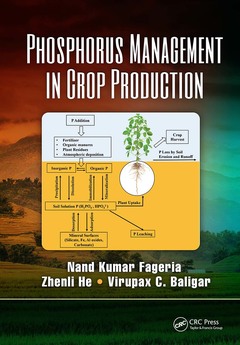Description
Phosphorus Management in Crop Production
Authors: Fageria Nand Kumar, He Zhenli, Baligar Virupax C.
Language: English
Subjects for Phosphorus Management in Crop Production:
Keywords
Shoot Dry Weight; Upland Rice Genotypes; cover; Upland Rice; upland; Tropical Legume Cover Crops; rice; Dry Bean; lowland; Lowland Rice; canavalia; Dry Bean Genotypes; ensiformis; Soil Fertility; tropical; Brazilian Oxisol; legume; Root Dry Weight; crops; Cc; soil; Soil Plant System; Cover Crop Species; Acid Soil; Ghi; Plant Nutrition Research; Cover Crop Treatments; Calopogonium Mucunoides; Mucuna Aterrima; Mucuna Deeringiana; Crotalaria Mucronata; Variable Regression Equation R2; Green Manure Crops; Spikelet Sterility; BRS Sertaneja
56.31 €
In Print (Delivery period: 14 days).
Add to cartPublication date: 06-2021
· 17.8x25.4 cm · Paperback
232.80 €
In Print (Delivery period: 15 days).
Add to cartPublication date: 02-2017
360 p. · 17.8x25.4 cm · Hardback
Description
/li>Contents
/li>Biography
/li>
The world population is projected to reach nine billion by 2050, and in the coming years, global food demand is expected to increase by 50% or more. Higher crop productivity gains in the future will have to be achieved in developing countries through better natural resources management and crop improvement. After nitrogen, phosphorus (P) has more widespread influence on both natural and agricultural ecosystems than any other essential plant element. It has been estimated that 5.7 billion hectares of land worldwide contain insufficient amounts of available P for sustainable crop production, and P deficiency in crop plants is a widespread problem in various parts of the world. However, it has been estimated that worldwide minable P could last less than 40 years. For sustaining future food supplies, it is vital to enhance plant P use efficiency.
To bring the latest knowledge and research advances in efficient management of P for economically viable and environmentally beneficial crop production in sustainable agriculture, Phosphorus Management in Crop Production contains chapters covering functions and diagnostic techniques for P requirements in crop plants, P use efficiency and interactions with other nutrients in crop plants, management of P for optimal crop production and environmental quality, and basic principles and methodology regarding P nutrition in crop plants. The majority of research data included are derived from many years of field, greenhouse, and lab work, hence the information is practical in nature and will have a significant impact on efficient management of P-fertilizers to enhance P use efficiency, improve crop production, promote sustainable agriculture, and reduce P losses through eluviations, leaching, and erosion to minimize environmental degradation.
A comprehensive book that combines practical and applied information, Phosphorus Management in Crop Production is an excellent reference for students, professors, agricultural research scientists, food scientists, agricultural extension specialists, private consultants, fertilizer companies, and government agencies that deal with agricultural and environmental issues.
WORLD PHOSPHATE SITUATION AND CHEMISTRY OF PHOSPHORUS IN SOIL AND FACTORS AFFECTING ITS AVAILABILITY TO PLANTS. FUNCTIONS OF PHOSPHORUS IN CROP PLANTS. DIAGNOSTIC TECHNIQUES FOR PHOSPHORUS REQUIREMENTS IN CROP PLANTS. PHOSPHORUS USE EFFICIENCY IN CROP PLANTS. PHOSPHORUS INTERACTIONS WITH OTHER NUTRIENTS. PHOSPHORUS AND ENVIRONMENT. MANAGEMENT PRACTICES FOR OPTIMIZING PHOSPHORUS AVAILABILITY TO CROP PLANTS. PHOSPHORUS NUTRITION RESEARCH IN CROP PLANTS: BASIC PRINCIPLES AND METHODOLOGY.




